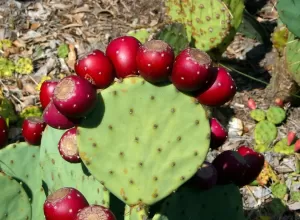A normally spineless variety of Opuntia cactus with large fruits growing on each pad. This species of cactus is grown world-wide to feed people, livestock and to restore degraded soils.
Opuntia ficus indica (prickly pear) was bred to be spineless by Luther Burbank in California in the early part of the 20th century. This spineless cultivar has spread around the world and is used principally as livestock feed throughout arid regions. It's fruit (including the peels) has many applications as a consumable, as well as applications in pharmaceuticals. The seeds render a valuable oil and can be ground into flour for baking. It's fibrous pads are also used to create bio-fuel and synthetic leather.
